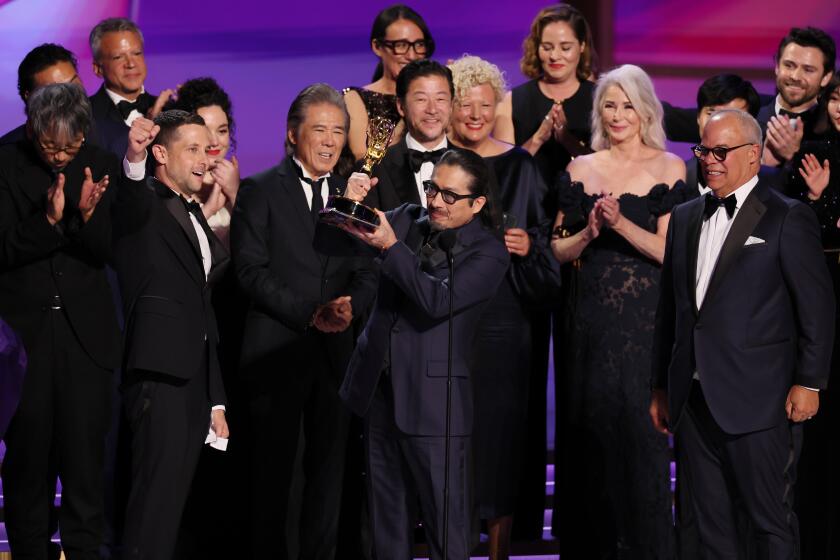MIXED MEDIA
Feeling
its age
Atomic Ranch:
Midcentury Marvels
$5.95
This quarterly, published in South Pasadena, espouses all the gee-whiz optimism of its sole subject matter: midcentury houses and the 1950s-obsessed young ‘uns who have reclaimed them. Unfortunately, Atomic Ranch looks and reads 50 years old, more like a lavish zine than a sophisticated niche read.
Publisher Jim Brown and editor Michelle Gringeri-Brown, the magazine’s Ward and June Cleaver, photograph and write most of the second 64-page issue, hitting mostly predictable notes.
Stories on a young couple who moved into a 1964 Eichler in Thousand Oaks and a hairdresser who renovated one of the Alexander Construction homes that define Palm Springs are long on personal details but short on aesthetic innovation and practical information. By contrast, the pictorial on the Salton Sea and a long piece on the all-metal, prefab Lustron house of the late 1940s are almost definitive histories.
The photography is documentary rather than dramatic, the overall design is dull, and captioning can be hit and miss. (Who designed that Scandinavian pendant light on page 11 and what did it cost?)
The biggest problem: pages with a jumble of small ads that appear after every story and destroy pacing. At least these ads provide valuable resources for midcentury shoppers, which may be the best reason to invest in Atomic Ranch.
-- David A. Keeps
Real and relevant
One Hundred Houses for One Hundred European Architects of the Twentieth Century
Gennaro Postiglione
Taschen, $36
Separating domesticity from the design of a home, even one with a grand architectural pedigree, is like enjoying a painting without looking at it. Homes in architectural books are often stripped naked, in limbo.
This book views architects’ homes as living spaces rather than as abandoned shells. Paintings and easels crowd the rubble stone wall of Le Corbusier’s studio. A head of lettuce awaits slaughter on a marble slab in Aurelio Galfetti’s modernist kitchen.
Each of 100 entries features a separate home: in-depth description, exterior photos, floor plan and bio of its architect. But, as editor Gennaro Postiglione writes, “The status of the domestic interior needs liberating” -- and so the book ventures indoors, and includes shots (in the case of Alvar Aalto, for instance) of the architect’s office, working area, living and dining rooms, even Aalto’s daughter’s room.
For architects, the design process continues indefinitely -- from laboring over the drafting table to picking out the kitchen table -- and it’s good to be along for the ride. One complaint: Editors should have included information on furnishings, because readers will want to borrow these inventive ideas.
Steven Barrie-Anthony
An artist revealed
Noguchi.org
Isamu Noguchi Garden Museum
Want a clue as to what made Isamu Noguchi the man when it came to modern design? Check out “I, Robot,” where his coffee table -- made of two counterbalanced pieces of ebonized wood with a glass top -- is futuristic enough for the action flick set in 2035, suggesting the piece is truly a classic.
If the recent flurry of centennial museum exhibitions and the release of a commemorative U.S. postage stamp has left you wanting less-fleeting proof of the designer’s enduring stature, you’ll find it at the Isamu Noguchi Garden Museum’s informational website.
The site contains an exhaustive survey of his intriguing life and work as a sculptor, architect and furniture designer. Noguchi, a Japanese American, was born in Los Angeles in 1904 (he died in 1988), but hobnobbed around the world with abstract sculptors such as Constantin Brancusi and architect Buckminster Fuller, building theatrical sets for dancer Martha Graham, commissioning furniture designs for the Herman Miller Co., and designing gardens such as California Scenario in Costa Mesa.
The site, built with a number of intuitive navigational paths, enables a browser to look at Noguchi’s work arranged by product (fountains, furniture) or materials used (paper, stone).
Filled with archival photos and Noguchi’s own recollections and essays, it provides a wealth of detail about one of the most versatile artists of the last century, the times he lived in and the people he knew.
-- David A. Keeps
More to Read
The biggest entertainment stories
Get our big stories about Hollywood, film, television, music, arts, culture and more right in your inbox as soon as they publish.
You may occasionally receive promotional content from the Los Angeles Times.










